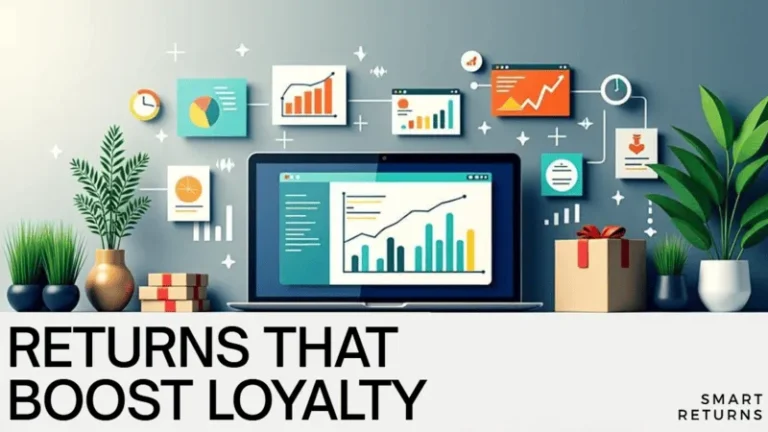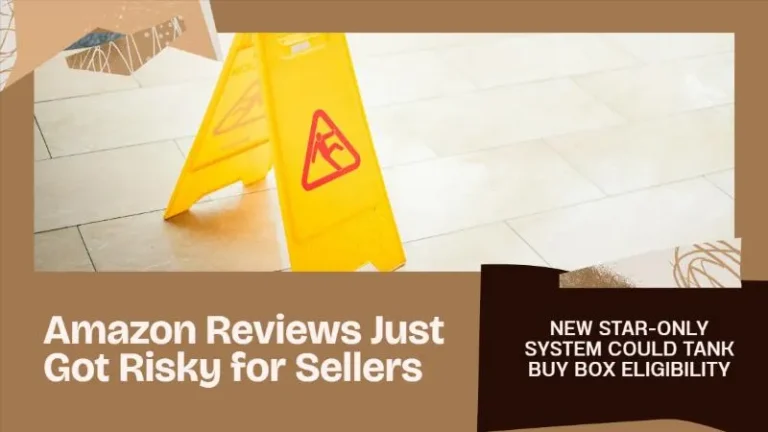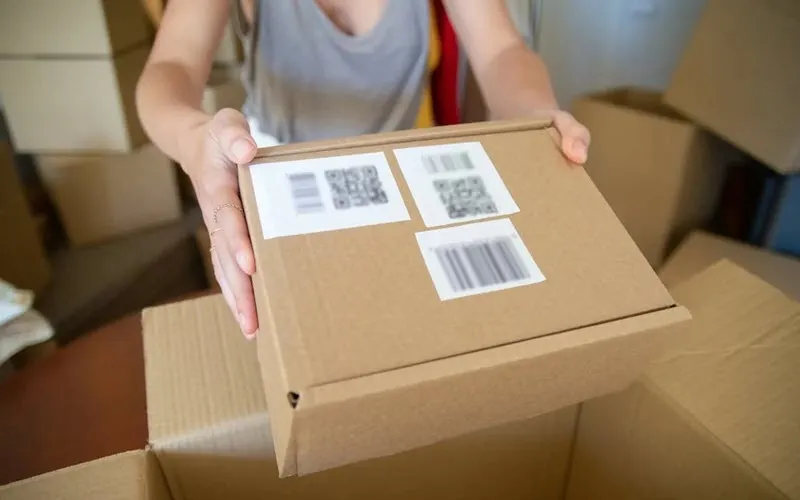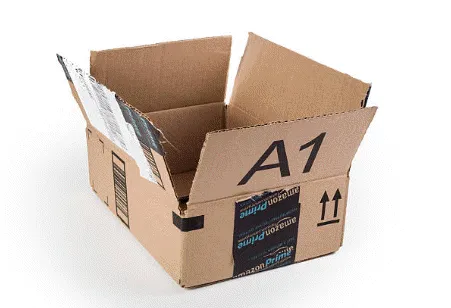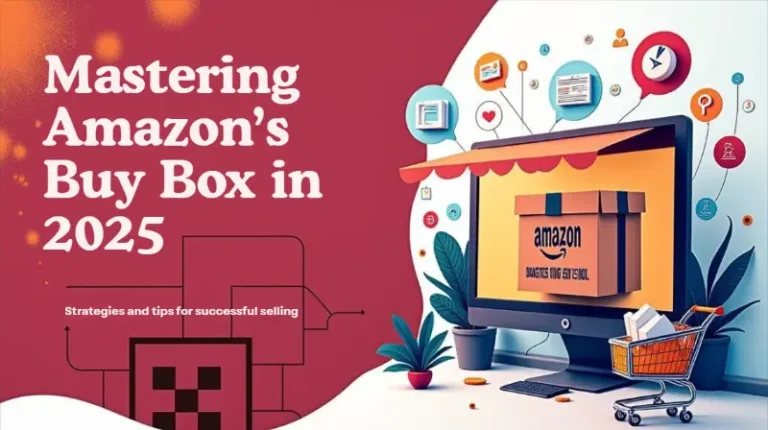Sustainable Ecommerce Returns: Why Sustainability Matters for Returns | Cahoot
In this article
 9 minutes
9 minutes
- Why Sustainability and Environmental Impact Matters to Consumers
- Actual Authentic Sustainability Programs are Hard Work
- Understanding the Environmental Impact of Ecommerce
- Capturing the Attention of Eco-Conscious Customers
- Sustainability Programs Generate Profit and Customer Retention
- Strategies for Implementing ESG Programs and Other Sustainable Practices
- Strategies for Reducing Returns
- Efficient Returns Management Systems
- Sustainable Practices in Returns Management
- Overcoming Challenges
- Building Long-Term Customer Loyalty
- Frequently Asked Questions
As environmental consciousness becomes a core value for consumers, ecommerce brands and retailers are rethinking their strategies to align with eco-friendly principles. This shift in consumer behavior (~78% of shoppers now include sustainability in their purchasing decisions) allows businesses to adapt early and convert this eco-conscious market ahead of others. Understanding why sustainability matters to consumers can help brands get ahead of competitors and capture their attention sooner. This can grow market share through stronger customer relationships built on mutual ideals, leading to long-lasting loyalty and higher lifetime value. Implementing and effectively communicating sustainability initiatives to customers can further enhance trust and loyalty.
Why Sustainability and Environmental Impact Matters to Consumers
Modern consumers increasingly recognize their role in addressing global climate challenges, many more recently citing sustainability as an important factor in their purchasing decisions. This signals an unspoken evaluation of businesses based on their environmental commitments. It wouldn’t be surprising to learn that the Millennials, Gen Z, and higher-income demographics lead this charge, often willing to pay premiums for eco-friendly products. Their motivations stem from a blend of personal values, social pressure, and a desire to support businesses that contribute to a healthier planet. Or at least don’t detract from one. Sustainable ecommerce order shipping and returns, which minimize waste and carbon emissions while maximizing profitability and customer loyalty, are a key aspect of these sustainable practices.
It’s important, however, to be aware that there’s a healthy amount of skepticism regarding the sustainability claims made by businesses, as nearly 90% of consumers are wary of greenwashing (the practice of making false or misleading claims about environmental actions and/or benefits), demanding verifiable data and authentic actions from brands. This growing awareness highlights the need for transparency and the measurable and verifiable impact of business efforts on the ecosystem.
Make Returns Profitable, Yes!
Cut shipping and processing costs by 70% with our patented peer-to-peer returns solution. 4x faster than traditional returns.
See How It WorksActual Authentic Sustainability Programs are Hard Work
To capture the attention of eco-conscious consumers, businesses must demonstrate genuine commitment to sustainability. Encouraging customers to retain low-cost items during the returns process as part of a Green Returns Initiative can promote sustainability by minimizing waste and shipping, while also enhancing customer satisfaction and engagement.
Transparent reporting is essential, with brands needing to publish sustainability reports that include concrete metrics such as carbon emissions reductions or resource savings. Ethical sourcing and business practices, supported by certifications, enhance credibility. Innovative product design that incorporates recycled materials, upcycled products and/or reduced waste or reusable goods plays a crucial role in meeting eco-conscious expectations. Purpose-driven marketing should authentically communicate a brand’s sustainability mission, avoiding vague claims while focusing on genuine storytelling that connects emotionally with consumers.
Understanding the Environmental Impact of Ecommerce
The environmental impact of ecommerce is significant; online shopping contributes to increased carbon emissions, waste generation, and energy consumption. The rapid growth of ecommerce has raised concerns about the environmental impacts of online shopping, highlighting the need for sustainable practices. Online retailers must understand the specific environmental impacts of their operations to develop effective strategies for reducing their environmental footprint. By addressing these issues, businesses can not only mitigate their environmental impact but also appeal to eco-conscious customers who prioritize sustainability in their purchasing decisions.
Capturing the Attention of Eco-Conscious Customers
We know that eco-conscious consumers are discerning, seeking authenticity and actionable impact. So, brands that want to attract this segment must offer engaging experiences that connect with their values. Developing interactive campaigns or gamification elements that reward sustainable choices fosters even deeper engagement. Simple education and awareness play an essential role in helping consumers make informed decisions by providing accessible resources that explain the environmental benefits of their products. Collaborations with eco-friendly organizations or other sustainable brands amplify efforts and build credibility, further strengthening consumer trust.
While attracting attention is a vital first step, converting eyeballs into loyal customers or even proponents and brand evangelists requires addressing barriers such as cost and accessibility. Clear value propositions are essential, emphasizing the durability, quality, and long-term cost savings of sustainable products. Affordable options make sustainability accessible to a broader demographic than older and more financially stable shoppers. Sharing relatable stories about how initiatives have positively impacted the environment and communities shows the human impact to sustainability and nurtures emotional connections with the brand.
Sustainability Programs Generate Profit and Customer Retention
Sustainability has become a crucial marketing and revenue element of ecommerce, as consumers increasingly prioritize eco-friendly practices and environmentally responsible businesses. By embracing sustainable practices, ecommerce businesses can not only reduce their environmental impact but also cater to the growing demand for eco-friendly options.
This approach not only builds customer loyalty but also ensures long-term customer satisfaction and retention. As consumers become more eco-conscious, they are more likely to support brands that align with their values, leading to a competitive advantage in the market.
Convert Returns Into New Sales and Profits
Our peer-to-peer returns system instantly resells returned items—no warehouse processing, and get paid before you refund.
I'm Interested in Peer-to-Peer ReturnsStrategies for Implementing ESG Programs and Other Sustainable Practices
Creating an Environmental, Social, and Governance (ESG) program and embedding sustainability into the core of business operations requires thoughtful planning and execution. Companies can start by optimizing supply chains, which include reducing emissions through efficient delivery routes, local sourcing, and consolidated shipments to reduce transportation cycles. Sustainable packaging that uses biodegradable or recyclable materials addresses consumer concerns about single-use plastics. Recycling programs such as H&M’s Garment Collecting Program incentivize customers to recycle used and unwanted apparel, contributing to a circular economy that benefits consumers and the planet.
Reducing the impact of ecommerce reverse logistics (product returns) on the environment is another way to support eco-conscious consumers. When optimized, a well-rounded Return and Exchange Program can play a profound role in reducing waste and conserving resources, allowing businesses to recover value from returned goods while minimizing environmental impact. For instance, establishing systems to inspect, refurbish, and resell returned items not only reduces landfill waste but also offers cost savings to consumers who are more than happy to accept a discounted “open box” item while also creating a new revenue stream for the retailer that may have otherwise contributed to revenue erosion.
Efficient reverse logistics strategies require careful planning and investment in technology and service partnerships. Brands can implement streamlined return processes that reduce emissions, such as consolidating shipments for returned goods or offering local drop-off points to minimize the impact of exhaust emissions from the repeated transportation of the same items back and forth between customers and processing facilities. Partnerships with next-generation returns programs specializing in hands-off and sustainable re-commerce solutions can further enhance these efforts. By integrating reverse logistics into their broader sustainability programs, brands and retailers demonstrate a holistic commitment to reducing their environmental footprint and delivering value to eco-conscious consumers.
Strategies for Reducing Returns
The best way to deal with returns is by not having any. Minimizing returns is crucial for reducing environmental impact as well as lowering operational costs. One effective strategy is providing comprehensive product information to manage customer expectations better. Detailed descriptions, high-quality images, and customer reviews can help shoppers make informed decisions, reducing the likelihood of returns.
Another approach is incentivizing customers to keep their purchases, which can reduce return rates. Offering discounts on future purchases or loyalty points can encourage customers to retain their items. Ensuring returned items are resold, donated, or recycled is also essential for reducing waste. By embracing these strategies, ecommerce businesses can lessen the environmental impact of returns and enhance customer satisfaction.
Efficient Returns Management Systems
Efficient returns management systems are crucial for enhancing customer satisfaction and streamlining operations. Implementing automated systems and tools can reduce the time and effort required for returns processing. Leveraging technology can empower ecommerce businesses to lower return rates and improve customer satisfaction. Focusing on boosting customer satisfaction through efficient returns processes is essential for building customer loyalty and retention. Considering sustainability in returns management practices is also vital for reducing waste and minimizing environmental impact. By optimizing inventory management and ensuring a seamless returns process, businesses can meet customer expectations while promoting eco-friendly practices.
No More Return Waste
Help the planet and your profits—our award-winning returns tech reduces landfill waste and recycles value. Real savings, No greenwashing!
Learn About Sustainable ReturnsSustainable Practices in Returns Management
Sustainable practices in returns management are essential for reducing waste and minimizing environmental impact. Implementing a closed-loop supply chain can help in recycling returned products, minimizing landfill waste. Partnering with third-party logistics providers can efficiently handle returns and ensure items are put back into inventory. Offering boxless returns such as in-store returns allows for immediate inspection and restocking, reducing the environmental impact. Implementing reusable packaging and dunnage saves on return shipping costs.
Adopting these strategies can enable retailers to guarantee that returned items are resold, donated, or recycled, reducing waste and promoting sustainability. By integrating these sustainable practices, businesses can enhance customer satisfaction and loyalty while contributing to a healthier planet.
Overcoming Challenges
Despite the benefits of sustainability, businesses often face obstacles such as balancing profitability with the cost of such programs. Proving product quality is also a key step. Consumers need to believe in the performance and reliability of eco-friendly alternatives to counter misconceptions about their effectiveness. Lastly, consistent communication about the sustainability journey, including successes, setbacks, and future goals, is vital in building and preserving consumer trust.
Building Long-Term Customer Loyalty
The path to building an eco-friendly brand reputation and attracting loyal, eco-conscious customers lies in making sustainability a shared journey. Creating opportunities for customers to participate in meaningful actions, such as planting trees or donating to environmental causes through purchases, helps build a sense of community and purpose. Highlighting their contributions to the broader global sustainability objectives reinforces the customer’s connection to the brand and its mission. By prioritizing transparency, innovation, and authentic engagement, brands, and retailers can align themselves with consumer values, driving profitability and lasting impact and presenting a powerful opportunity to redefine success in an environmentally conscious world.
Frequently Asked Questions
Why are sustainable ecommerce returns important?
Sustainable eCommerce returns are important because they reduce environmental impact and enhance customer satisfaction by minimizing waste and promoting eco-friendly practices. This helps lower carbon emissions and create a positive shopping experience for customers.
How can ecommerce shipping be done sustainably?
Choose sustainable packaging such as biodegradable bags and packing peanuts. Use the right sized packaging. Have packaging be re-usable for returns.
How can ecommerce environmental impact be measured?
Regularly track metrics like carbon emissions associated with shipping and packaging to identify areas for improvement. Provide customers with accurate reports to show the business commitment and progress towards reducing carbon emissions and waste reduction.
Why is it important to have a sustainable return policy?
A sustainable return policy helps minimize environmental footprint by reducing waste and also reduces packaging costs for businesses.

Turn Returns Into New Revenue
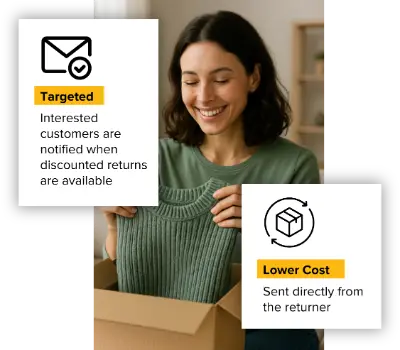
Crafting the Perfect Ecommerce Returns Program | Cahoot
In this article
 15 minutes
15 minutes
Ecommerce returns are an unavoidable aspect of online retail, and return rates have been steadily rising (averaging 20-30% across the industry, compared to under 10% in brick-and-mortar stores). This results in a critical challenge for retailers and a complex consumer experience. What was once a simple transaction has transformed into a nuanced ecosystem of choice. As consumers become comfortable moving more and more of their purchases online to take advantage of the nearly infinite product selection, they likewise become comfortable returning those purchases.
Understanding the Impact of Returns on Online Sellers
The reasons behind returns are as diverse as the products being shipped back. Some returns stem from practical issues like incorrect apparel sizing, inaccurate product descriptions, or items that don’t match online imagery. Others are driven by more strategic consumer behaviors like “bracketing,” where shoppers intentionally order multiple variations of a product, planning to keep only one, or “wardrobing,” where items are worn and then returned (a form of returns fraud). These practices exacerbate returns rates, posing significant challenges for online retailers in terms of inventory management, customer service, and logistics.
Regardless of the reason for the ludicrous $500+ billion value of goods returned in the US in 2024, the cost of supporting them is increasing with no relief in sight. The cost of labor is rising every year. The costs from transportation, real estate and facility operations, returns processing, and loss of sellable inventory… go up yearly. But while ecommerce retailers and brands can’t afford to alienate customers and disincentivize returns, they likewise can’t ignore the increasing margin erosion. An exceptional returns process builds trust, improves customer satisfaction, and encourages repeat purchases. Numerous studies have found that ~92% of consumers will buy from a retailer again if the return process is easy.
Brands must balance the costs of supporting returns with the benefits of customer loyalty. Consumers want to know their options before buying to ensure a hassle-free experience. Sellers wish to encourage conversion because acquiring a customer can cost five times more than retaining one. Offering free or hassle-free returns can make a business more appealing but also comes with challenges, especially for smaller merchants. Some Sellers use innovative strategies like peer-to-peer return solutions, localized drop-off points, or charging restocking fees to manage costs. Some leverage help from third-party logistics (3PL) partners to outsource returns management to minimize operational overhead such as inspection, relisting, processing, and issuing refunds. The item can then be stored at the 3PL to fulfill a new order.
The most cost-effective reverse logistics strategy involves leveraging a centralized returns center with a dedicated location to handle returns and specially trained (highly efficient) staff. It also involves automating processes wherever possible, utilizing return-ready packaging that can be easily resealed and reused to eliminate repackaging costs, and analyzing return data to identify trends and proactively address common return reasons. Streamlining the returns process through technology and efficient management minimizes labor costs and optimizes inventory handling and tracking.
However, most of the costs associated with returned orders lay in the transportation. Sellers can certainly negotiate better shipping rates, but there’s a limit to what discounts can be achieved, and Sellers that fully outsource their fulfillment to 3PLs don’t even have control over that piece of the puzzle. So, how can you introduce a competitive ecommerce returns program that accommodates all different types of returns? Let’s take a look:
Make Returns Profitable, Yes!
Cut shipping and processing costs by 70% with our patented peer-to-peer returns solution. 4x faster than traditional returns.
See How It WorksStrategies to Minimize Returns
The first step in implementing an exceptional returns program to encourage customer loyalty is to spend the time to avoid returns in the first place. Businesses should focus on the many aspects of the customer experience that lead to returns. Additionally, companies should invest in packaging and void fill sufficient to prevent damage in transit. Lastly, merchants can identify and address the root causes of returns by carefully monitoring return trends beyond these suggestions.
To minimize returns, online retailers can focus on providing clear and detailed product information. This includes providing accurate product information using high-quality images and comprehensive descriptions, implementing robust sizing guides, and encouraging customer reviews to help potential buyers. When customers have all the information they need to make informed purchasing decisions, they are less likely to return items. For example, in the apparel industry, providing detailed measurements and fit guides can help customers choose the right size, reducing the likelihood of returns due to sizing issues.
Additionally, offering virtual try-on tools, such as augmented reality (AR) and 3D models, can allow customers to see how a product fits and looks without having to physically try it on. These tools provide a more accurate representation of the product, helping to reduce the number of returns and improve customer satisfaction. By investing in these technologies, online retailers can enhance the online shopping experience and build customer loyalty.
Leveraging Technology to Improve Returns
Technology can play a significant role in improving the returns process for online retailers. Returns management systems can help track and manage returns, making it easier to identify areas for improvement. These systems can automate many aspects of the returns process, reducing the time and effort required to handle returns.
Additionally, data analytics can provide insights into return trends and patterns, allowing online retailers to make data-driven decisions to minimize returns. By analyzing return data, retailers can identify common reasons for returns and take proactive steps to address them. For example, if a particular product has a high return rate due to sizing issues, the retailer can update the product descriptions and sizing charts to provide more accurate information.
Returns via Small Parcel Shipping
Ecommerce returns by small parcel shipping (USPS, UPS, FedEx, etc.) offer convenience for customers by allowing them to simply repackage their order, print and affix a pre-paid shipping label, and then either schedule free carrier pickup (in most cases) or dropoff to a convenient carrier location or network store such as a UPS Store, FedEx Office, or the like. But this type of return comes with major drawbacks, including very high shipping costs, the potential for the package to be lost or damaged in return transit, shipping delays that prevent the inventory from being resold and fulfilled promptly, lengthier time to refund/credit which is beyond the customer’s expectations because item inspection naturally takes longer.
Customers may be happier with parcel shipping directly to the returns processing facility (maybe they’re in a more rural setting, and it’s more convenient to choose their preferred carrier). Still, the extra shipping is terrible for the planet. Merchants will likely use lower-cost shipping available, which could potentially lead to additional delays. Merchants could receive hundreds or thousands of small parcel deliveries at a time that must be opened, inspected, perhaps rebarcoded with the accurate SKU for the condition, put away, inventory tracked, item relisted for sale, and the cycle begins again.
Another huge disadvantage is the removal of checks and balances against returns fraud. Trusting Sellers (or those looking to build trust with their customers by quickly refunding) may receive the wrong item back, no item at all, or a box of rocks (true story). Returns fraud and abuse substantially increase the overall cost of returns.
Convert Returns Into New Sales and Profits
Our peer-to-peer returns system instantly resells returned items—no warehouse processing, and get paid before you refund.
I'm Interested in Peer-to-Peer ReturnsBoxless Returns
Boxless returns have several advantages. Firstly, transportation is the largest cost in ecommerce reverse logistics (assuming high-value items were not damaged in transit and returns fraud and abuse are not a factor). Giving the customer the option to bring the items to a local returns desk (aka attended kiosk) allows for consolidating returns into larger shipments sent to a regional facility in groups, reducing transportation costs considerably. They can then be sorted en masse and further consolidated so that full truckloads containing tens of thousands of units from nationwide kiosks are delivered to the returns facilities at once and ready for bulk processing. This allows retailers to prioritize the processing and resale of higher-value items first, maximizing the value of the recaptured revenue. It also reduces time and cost for the items shipped directly to liquidators or donation centers, skipping wasteful transit and processing time and cost.
Another benefit of boxless returns is the real-time ‘inspection’ at the time of dropoff of the items at the attended kiosk. The attendant may not thoroughly inspect the item for authenticity, damage, etc., but at least the retailer knows that an item is coming back and that it’s not a box of rocks.
Finally, this returns process appeals to the eco-conscious consumer by reducing packaging waste, which translates into more savings for Sellers.
On the other hand, most retailers don’t have the infrastructure to support nationwide boxless returns, requiring an attended kiosk within 10 – 12 miles of each customer. So this usually requires fully outsourcing the reverse logistics, at least until the point of delivery at the returns processing facility. This adds a layer of complexity, which adds cost. Plus, returns need to accumulate at the kiosks to some extent to achieve the most benefit from consolidation before shipping to the second consolidation facilities for final sortation and consolidation. The result is inherently built-in delays. However, the transparency offered by the returns partner allows some visibility into what’s coming back and approximately when and allows Sellers to ‘pre-sell’ the incoming returned units, which recaptures revenue more quickly.
Merchants must ensure customers understand what is expected and provide sufficient guidance to avoid confusion regarding boxless return procedures.
Buy Online Return In Store (BORIS)
Retailers with physical stores may consider allowing ecommerce customers to return their items in person. This is called Buy Online, Return In Store (BORIS). The returned goods can then be inspected and sold to future in-person customers or shipped in bulk to a returns processing facility for the next steps.
This can be more convenient for customers who live nearby and may want to exchange the item(s) for different ones but want to touch the alternatives (e.g., different sizes or colors) before deciding. That gives them more confidence in future online purchase decisions because they know their size in that brand. It also entices customers to make alternate purchases (upsell/cross-sell) using in-store coupons or promotions.
Kohl’s and Staples are particularly good at this, both for their own ecommerce returns and those of their partners for whom they serve as attended kiosks for boxless returns. Returns fraud and abuse are also less likely in these cases, and for items that can be resold in the store, processing, and resale occurs much quicker than any other returns approach as items are inspected ‘on the spot.’
More in-store traffic, increased brand and location awareness, and opportunities to delight new customers with the in-store experience are all key benefits to BORIS. Exchange is also more likely than a refund, preserving revenue and lowering overall costs by eliminating transportation costs in most cases. As discussed earlier, this eliminates the likelihood of items being lost or damaged in transit.
It’s important to remember that this BORIS does not eliminate logistics costs. The transaction must still be tracked; employees must provide customer service, inventory updates, liquidation or donation, and tax implications if the items aren’t resellable. So, there’s still some complexity, but overall, it’s an excellent option for ecommerce customers.
No More Return Waste
Help the planet and your profits—our award-winning returns tech reduces landfill waste and recycles value. Real savings, No greenwashing!
Learn About Sustainable ReturnsHome Pickup
Home pickup for ecommerce returns can significantly increase customers’ convenience and satisfaction. However, it also comes with operational challenges, such as increased costs and logistics complexities, which require careful consideration of the pros and cons before implementing such a service. The service is flexible because it often leverages the gig economy or specialty couriers, so it can be applied regionally using lower-cost transportation methods, depending on volume.
Further, a home pickup option can be perceived as a customer-centric service, improving brand image and customer loyalty. Many of these hyper-local services can support box-free home pickup, which helps when customers don’t want to procure packaging for their return or simply appreciate the option of a zero-waste return.
Home pickup does make returns more accessible, however, so customers may be more likely to return items they no longer want, potentially leading to higher ecommerce return rates. And it’s not without complexity as a third-party partner(s) manages logistics to coordinate. If several returns cannot be collected during a single trip around an area, transportation costs can actually increase rather than provide relief. However, if a retailer’s products are in a category or serve a demographic that would endear customers – or if this option is reserved for VIP clients – it can be a big win to include it as part of a returns program.
Keep It (Returnless Refund)
Have you ever created an ecommerce returns request only to be surprised by the Seller telling you not to bother sending it back? Packaging it up and dropping it off at a kiosk or locker is unnecessary. Just keep it, donate it, toss it, whatever you want, and you still get your refund.
Some retailers offer customers the option to keep the item based on purchase history, lifetime value, and/or no previous patterns of return abuse. And there are several scenarios where the ‘Keep It’ approach makes the most sense. For example, transportation costs for low-value or low-margin items could easily spin out of control. For items with sanitary concerns that cannot be resold, such as undergarments or mattresses, eliminating the time and cost of customer service and managing the returns, shipping, and processing might make the most sense.
Keep-it policies also help reduce the impact of returns on excess stock, which can cost a merchant even more by way of storage costs, space congestion that limits the ability to stock new products, and processing costs. Excess inventory is not considered a favorable position, precisely because of such negative impacts on operational efficiency.
Summary
Ultimately, ecommerce returns are a trade-off: they hurt margins but are essential to compete in a market where convenience and customer-centric policies drive success, because there’s always another place to get the item. No retailer is irreplaceable, especially in ecommerce.
The source of the problem primarily stems from customers’ inability to physically inspect products before purchase, leading to returns due to sizing, description discrepancies, or even shipping damage. Crafting the perfect ecommerce returns program requires Sellers to understand their core customer demographic and meet them where they are, which means offering the options customers prefer while managing costs. As customers have amazing experiences shopping with your competitors or even across categories, they naturally seek out similar experiences for future purchases.
The most common approaches to a returns program are small parcel returns, boxless returns, buy online return in-store (BORIS), home pickup, and returnless refunds. Each method offers unique advantages and challenges, but despite the associated costs and complexities, an exceptional returns program is crucial to building customer trust and loyalty.
Ecommerce has matured to the point that expectations have already been set before checkout. Retailers who follow through on the unspoken social agreement and even delight customers by going above and beyond are rewarded with trust, loyalty, and repeat customers as a result. A retailer’s probability of selling to a returning customer is higher than selling to a new customer, and repeat customers spend more than brand-new shoppers. Instead of viewing a purchase as the end goal in a transaction, sellers should approach the entire post-purchase journey as the start of a customer relationship that needs to be nurtured for it to grow and flourish over time.
Frequently Asked Questions
How can I reduce my number of returns?
Reducing returns starts with clear product descriptions, high-quality images, and accurate sizing charts. Providing detailed specifications and addressing common customer concerns in FAQs can help set expectations, and ensuring quality control before shipping and offering responsive customer support can minimize unnecessary returns.
What should I do with returned items that can’t be resold as new?
Depending on the item’s condition, you might be able to refurbish, discount, or resell it as an “open box” item. Some sellers donate returns to charity or work with liquidation companies. If using FBA, Amazon may offer refurbishment services, but fees will apply.
What are the benefits of offering free returns?
Offering free returns can increase customer satisfaction and loyalty, leading to higher repeat purchase rates. It can also reduce the perceived risk of buying online, encouraging more customers to make a purchase. However, it’s important to balance the costs of free returns with the potential benefits.

Turn Returns Into New Revenue

The Silent Profit Killer: Returns Fraud and Refund Fraud Exposed
Retail is under siege by a sophisticated form of economic sabotage that threatens the very foundation of online commerce as it silently erodes retail profitability. The rise of online shopping has a corresponding rise in online returns with a significant increase in return fraud, as the convenience of ecommerce has made it easier for fraudsters to exploit return policies. Returns fraud and refund fraud have transformed from a minor inconvenience into a multibillion-dollar crisis that undermines the entire ecommerce ecosystem. In 2022, an estimated $816 billion of merchandise was returned in the United States, with a staggering $84.9 billion classified as fraudulent (more than 10%). The problem has grown rapidly, initially fueled by the explosive ecommerce growth during the COVID pandemic, with retailers experiencing a 67% increase in return rates over the past five years.
What is Return Fraud?
Return fraud refers to the act of manipulating a retailer’s return policy for personal gain. This deceptive practice involves exploiting the return process to obtain a refund, exchange, or store credit under false pretenses. Return fraud can manifest in various forms, including receipt fraud, where fake or altered receipts are used to return items, and price switching, where barcodes or price tags are swapped to secure a higher refund. Wardrobing, another common tactic, involves purchasing items with the intention of using them temporarily before returning them. According to the National Retail Federation, return fraud costs retailers billions of dollars each year, posing a significant challenge for both online retailers and brick-and-mortar stores.
The Economic Impact of Refund Fraud
The scale of returns fraud is staggering, and the financial consequences extend far beyond simple refunds, encompassing a wide range of fraudulent activity. Processing a single return costs an average of 20% – 30% of the original order value. The total annual cost of retail fraud has ballooned to $101 billion, with holiday seasons seeing returns fraud account for nearly 20% of all returns.
Make Returns Profitable, Yes!
Cut shipping and processing costs by 70% with our patented peer-to-peer returns solution. 4x faster than traditional returns.
See How It WorksTypes of Fraudulent Returns
There are several types of fraudulent returns that retailers need to be aware of. These include:
- Receipt Fraud: This involves creating or altering receipts to return stolen merchandise or items purchased at a discount for a full refund. This intricate scheme targets both online and physical retail stores. To effectively combat these schemes, retailers must employ advanced tools and strategies to detect return fraud and protect their bottom line.
- Price Switching: A deliberate manipulation requiring careful execution whereby barcodes are altered, or price tags are swapped between two items with distinctly different prices to obtain larger refunds. For example, one might purchase a higher and lower-priced item, swap price tags between the two, and then return the lower-priced item for the higher refund amount. Or they may modify the barcode on an item to trigger a more favorable refund.
- Product Swapping: A type of return fraud where a new condition item is purchased and then an older, worn, or broken item is returned in the new product’s packaging. The business approves the refund, not knowing about the deception until the next customer has a bad purchase experience.
- Empty Box Fraud: The scammer reports that the box was delivered empty or missing some of the intended contents, requesting a refund or replacement without shipping anything back to the retailer.
- No Delivery Claim: Customers claim their order was not delivered and claim a full refund when the item(s) were indeed delivered; keeping both the item and the refund.
- Chargeback Fraud: Customers dispute legitimate charges with their credit card company, claiming the transaction(s) were not unauthorized or that they never received the product (similar to making a No Delivery claim with the Seller). This forces the retailer to prove the order’s validity or lose the value of both the product and the revenue.
- Wardrobing: This involves purchasing an item with the intention of only using it temporarily, and then returning it for a full refund, effectively “renting” the product for free. This is particularly common for luxury items that might be needed for one-time events or one-time use, such as parties, meetings, or to complete a non-recurring task, treating online retailers like free rental services.
- Employee Collusion: This involves dishonest employees collaborating with outside individuals to manipulate the return process or facilitate fraudulent returns.
- Cross-Retailer Return Fraud: This involves purchasing an item at a discount from one store and then returning it for its full retail value at another retailer.
- Bogus Product Defect: A customer falsely claims that a product was delivered damaged or otherwise defective to either secure a refund without returning the item or to receive a replacement and complete the transaction, having acquired two for the price of one. This involves fabricating or exaggerating product flaws to trigger the retailer’s return or replacement policy without genuine grounds for the claim.
- Store Credit Abuse: Store credit abuse is a type of return fraud that involves manipulating the return process to obtain store credit or refunds under false pretenses. This can include returning items that were not purchased or returning items that are not in their original condition. To prevent store credit abuse, retailers can implement strict return procedures, such as requiring receipts and identification for returns. Limiting the amount of store credit that can be issued for returns and monitoring transaction data to detect suspicious activity are also effective measures. By taking these steps, retailers can reduce the risk of store credit abuse and protect their business from fraudulent activities.
- Component Stripping: Primarily targeting high-end electronics; scammers purchase the devices, remove valuable components to sell them, and then return the items with the missing components. Often, retailers have no idea until the item is resold and doesn’t work for the next customer.
- Bracketing: A risk management shopping approach where customers intentionally order multiple variations of a product, knowing in advance that they will only be keeping one or a select few. The convenience of browsing online catalogs and knowing that the returns will be free allows consumers to “try it before they truly buy it.”
These fraudulent activities not only erode profitability but also complicate inventory management and customer service efforts.
Convert Returns Into New Sales and Profits
Our peer-to-peer returns system instantly resells returned items—no warehouse processing, and get paid before you refund.
I'm Interested in Peer-to-Peer ReturnsConsequences of Return Fraud
The consequences of return fraud can be severe for retailers. According to the National Retail Federation, return fraud costs retailers an estimated $100 billion each year. Beyond the immediate financial losses, return fraud can damage a retailer’s reputation and erode customer trust. When customers perceive a retailer as vulnerable to fraud, they may question the integrity of the business, leading to a decline in customer loyalty. Additionally, return fraud can create significant inventory management issues, as retailers may not receive the items back that they think they have, further complicating stock control and forecasting.
Preventing Return Fraud
Preventing return fraud requires a multi-faceted approach. Retailers can start by implementing clear return policies and communicating them effectively to customers. Cutting down on legitimate return causes helps separate returns from return fraud. Utilizing digital tracking and online portals to record each customer’s return history can help detect fraud patterns. Advanced technologies like machine learning algorithms, artificial intelligence, and fraud detection software are invaluable tools in identifying and preventing fraudulent returns. Training employees to recognize and prevent return fraud is also crucial. By equipping staff with knowledge and tools to spot suspicious activities, retailers can significantly reduce the risk of fraudulent returns.
Summary of Refund and Returns Fraud
Returns fraud represents a complex economic challenge requiring continuous monitoring and adaptation. Retailers must remain vigilant and leverage the latest fraud detection tools and technology while designing a returns program that protects their bottom line while encouraging customer trust and loyalty. By employing technology, training employees to spot patterns, and consistently enforcing return policies, retailers can prevent systemic abuse and minimize the impact of fraudulent activity on profitability. The battle against returns fraud transcends simple loss prevention. The ability to detect, prevent, and mitigate fraudulent returns and refunds will separate successful retailers from vulnerable targets.
Frequently Asked Questions
How serious is return fraud?
Return and Refund fraud costs sellers $100 billion a year.
How to prevent return fraud?
The less anonymous people are when doing returns, the harder fraud becomes. Requiring customer ID or other details beyond just a receipt makes fraud harder.
Is return fraud hard to prove?
Yes. It’s hard to separate legitimate returns from return fraud.

Turn Returns Into New Revenue

Related Blog Posts
How to Optimize Reverse Logistics
Reverse logistics has emerged as a vital aspect of supply chain management in modern ecommerce, and its reach continues to expand. While it still includes the movement of goods from customers to retailers, it’s no longer limited to just handling returns. It encompasses customer communication and expectation setting, order and inventory management, repairs, recycling, resale, and recommerce and can have substantial revenue implications. With ecommerce return rates averaging 20–30% across categories, businesses must adopt innovative strategies to optimize reverse logistics to balance efficiency, profitability, customer relationships, loyalty, and sustainability. Implementing an effective reverse logistics strategy not only reduces operational costs but also enhances customer satisfaction while promoting sustainability efforts.
What is Reverse Logistics?
Reverse logistics refers to a specialized segment of supply chain management that focuses on the movement of goods from the customer back to the retailer or manufacturer. The process is initiated for various reasons, including product damage, seasonal inventory adjustments, restocking, salvage, recalls, or managing excess inventory. It crucially enables companies to regain value from returned products, reduce waste, and significantly improve customer satisfaction. By efficiently handling returns, businesses can enhance their overall supply chain performance and foster stronger customer relationships.
Reverse Logistics vs. Traditional Logistics
While traditional logistics involves the forward movement of goods from the manufacturer to the customer, reverse logistics focuses on the backward flow of products from the customer back to the retailer or manufacturer. The primary distinction between the two lies in the direction of product flow. Traditional logistics aims to ensure timely and efficient delivery of products to customers, optimizing the supply chain to meet demand. In contrast, reverse logistics deals with the complexities of retrieving products from customers, managing returns, and processing these items for resale, refurbishment, or disposal. This reverse flow is essential for managing returns efficiently, reducing waste, and maintaining customer satisfaction, making reverse logistics a critical component of modern supply chain management.
Make Returns Profitable, Yes!
Cut shipping and processing costs by 70% with our patented peer-to-peer returns solution. 4x faster than traditional returns.
See How It WorksThe Importance of Reverse Logistics
Reverse logistics has become a pivotal part of retail success, influenced by changing consumer desires and behavior. For example, well over 50% of online shoppers now report engaging in “bracketing,” the practice of purchasing multiple product variations to return those that do not meet their needs. This necessitates sustainability programs that mitigate the increased environmental considerations, as estimates put the carbon emissions related to reverse logistics near 25% of the total ecommerce footprint.
Returns management impacts operational costs and brand loyalty, as customers are significantly more likely to make repeat purchases following a retailer’s smooth returns experience. Clear and comprehensive return policies can significantly improve customer service by making the returns experience straightforward, providing a competitive edge in the market.
Optimized reverse logistics delivers numerous advantages, from enhanced inventory management and quick reintegration of resellable items, to streamlined processing for reducing operational expenses, to refurbishing and reselling non-new items to generate creative income streams where products might otherwise have gone to the landfill. Efficient returns handling software and processes build customer trust and loyalty, and proper recycling and waste management mitigate sustainability challenges.
What is the Reverse Logistics Process?
The reverse logistics process is multifaceted, involving several key components that work together to manage returns, reduce waste, and enhance customer satisfaction. These components include:
- Returns Management: This involves overseeing the return of products from customers, including processing refunds, exchanges, and repairs. Effective returns management ensures a smooth and hassle-free return process, which is crucial for maintaining customer satisfaction.
- Return Policy and Procedure (RPP): Establishing a clear return policy and procedure is essential. An effective policy should outline the rules and guidelines for returning products, ensuring that customers are well-informed and that the return process is consistent and transparent.
- Remanufacturing, Refurbishment, or Replacement: This involves repairing or replacing defective products or remanufacturing items to make them suitable for resale. By refurbishing returned products, companies can reduce waste and recapture value.
- Packaging Management: Managing the packaging of returned products is vital to minimize waste and reduce the environmental impact of returns. This includes using sustainable packaging materials and optimizing packaging processes.
- Unsold Goods: This component deals with managing unsold products returned from retailers or distributors. Strategies may include disposing of, recycling, or reselling these products to minimize losses and reduce waste.
- End-of-Life (EOL) Products: Managing products that have reached the end of their life cycle involves recycling, refurbishing, or disposing of these items responsibly. This component is crucial for sustainability and reducing the environmental footprint of returns.
- Delivery Failure: Handling failed deliveries involves re-routing or re-delivering products to customers. Efficient management of delivery failures ensures that customers receive their products promptly, maintaining customer satisfaction.
By understanding and effectively managing these components, companies can develop robust reverse logistics processes that optimize returns management, reduce waste, and enhance customer satisfaction.
Convert Returns Into New Sales and Profits
Our peer-to-peer returns system instantly resells returned items—no warehouse processing, and get paid before you refund.
I'm Interested in Peer-to-Peer ReturnsCore Strategies for Optimization
1. Technology Integration: Integrating advanced technologies is key to streamlining reverse logistics operations and optimizing inventory management. Solutions include:
- Warehouse Management Systems (WMS), which enable real-time tracking and management of returns and exchanges, centralizing all customer communication, automating where possible, and creating and managing workflows for maximum efficiency.
- Inventory Management Systems (IMS) are used to authorize customer returns, return shipping, inspection, categorization, and resale/redistribution of returned goods.
- Implementing software systems that create efficient return and exchange workflows, enabling customers with a self-service portal and a consistent but straightforward process for making returns, requesting exchanges, and suggesting upsell and cross-sell items to retain revenue rather than providing full refunds. Employing robotic systems for sorting, inspecting, and storing returned items to remove as much of the human from the process as possible, decreasing the returns program’s overall cost.
2. Data-Driven Decision-Making: Closely analyzing data can provide valuable insights into returns management trends and help address root causes to prevent future returns. Retailers can:
- Capture and analyze the reasons for returns and fix the issues, such as manufacturing defects or inaccurate product descriptions, that are leading to mismatched customer expectations.
- Use returns data to improve product design and to design new products that align offerings with customer preferences.
- Use returns data to implement disposition rules that streamline returns processing to reduce the time to resale.
- Use predictive analytics to forecast returns and optimize inventory procurement.
3. The Importance of Sustainability: Environmental responsibility is an integral part of modern reverse logistics. Strategies include:
- Repairing/refurbishing and reselling returned items to minimize waste.
- Partnering with local organizations to recycle unsalvageable products.
- Investing in durable shipping materials to reduce packaging waste.
- Engaging in the circular economy and encouraging recommerce through platforms like ThredUp and Arrive Recommerce.
4. Customer-Centric Solutions: Prioritizing customer experience ensures loyalty and reduces friction. Retailers should:
- Offer multiple return options, including in-store returns, home pick-up, and drop-off points such as lockers.
- Implement a clear and transparent return policy and prominently display the details using simple website language.
- Offer printerless and boxless return solutions with easy-to-follow procedures.
- Provide regular status updates and quick refunds to reinforce trust and transparency.
5. Consolidation and Localization: Consolidating returns locally can significantly reduce costs and environmental impact by reducing the transportation burden. However, this is not a one-size-fits-all strategy. For example, high-value items, seasonal items, or those in high demand in a particular region should be sent directly to the store or warehouse most likely to resell or ship the item(s) quickly to maintain resale value.
6. Policy Development: Developing competitive yet viable return policies is essential for efficient supply chains. Key practices include:
- Implementing category-specific restrictions to manage expectations and costs.
- Setting clear guidelines for handling high-value items.
- Offering premium return and/or exchange services for VIP customers, such as free returns or bonus store credit for exchanges.
- Training staff to handle returns efficiently or partnering with specialized third-party logistics providers to outsource returns operations and minimize expenses.
No More Return Waste
Help the planet and your profits—our award-winning returns tech reduces landfill waste and recycles value. Real savings, No greenwashing!
Learn About Sustainable ReturnsSummary
Optimizing reverse logistics is no longer optional. It has become essential for thriving in today’s modern ecommerce landscape. Technological advancements and evolving consumer behavior patterns will shape its future. Retailers should explore innovations such as agentic artificial intelligence to create a more robust and personalized customer experience that operates 24/7/365. Blockchain technology can improve transparency and traceability within the supply chain. At the same time, collaborative platforms enable logistics solutions from outsourcing returns entirely to helping offload inventory through third-party recommerce channels. Businesses must also prioritize sustainability, integrating eco-friendly practices to meet consumer expectations, and it’s also just good citizenship. Balancing customer convenience with cost control will remain a central challenge, requiring continuous adaptation and investment in innovative returns solutions. A well-executed reverse logistics strategy minimizes costs, strengthens customer relationships, and reinforces a brand’s commitment to environmental responsibility.
Frequently Asked Questions
What is reverse logistics?
Reverse logistics refers to the process of moving goods from customers back to retailers or manufacturers for reasons such as returns, repairs, recycling, or disposal. It aims to regain value from returned products, reduce waste, and improve customer satisfaction.
How does reverse logistics differ from traditional logistics?
Traditional logistics focuses on the forward movement of goods from manufacturers to customers, while reverse logistics deals with the backward flow of products from customers back to retailers or manufacturers. Reverse logistics involves managing returns, refurbishing products, and reducing waste.
Why is reverse logistics important for ecommerce businesses?
Reverse logistics is crucial for ecommerce businesses as it helps manage returns efficiently, reduce operational costs, and enhance customer satisfaction. It also supports sustainability efforts by minimizing waste and promoting recycling and refurbishment.
What are some core strategies for optimizing reverse logistics?
Core strategies for optimizing reverse logistics include integrating advanced technologies, analyzing data for decision-making, prioritizing sustainability, offering customer-centric solutions, consolidating returns locally, and developing competitive return policies.

Turn Returns Into New Revenue

Encouraging Customer Loyalty with an Exceptional Returns Program
In this article
 12 minutes
12 minutes
- What is a Returns Policy?
- Understanding the Importance of a Returns Program
- Create a Clear, Customer-Friendly Return Policy
- Benefits of a Customer-Centric Returns Program
- Building a VIP Loyalty Program Around Returns
- Incentivize Exchanges Over Refunds
- Process Customer Returns Quickly via Automation
- Collect Customer Feedback to Improve Customer Satisfaction
- Clearly Display Returns Policy for Customer Ease of Access
- Summary
- Frequently Asked Questions
In the highly competitive world of ecommerce, delivering an exceptional customer experience is the key to fostering long-term loyalty. While much focus is placed on the initial purchase journey, the often-overlooked return process can make or break a customer’s relationship with a brand. While many ecommerce businesses view returns as a painful but necessary evil, forward-thinking retailers are discovering their untapped potential for building customer loyalty. In today’s competitive marketplace, a positive returns experience can transform one-time shoppers into lifelong brand advocates, driving sustained growth and profitability.
The challenge lies in meeting the lofty expectations set by industry giants. Shoppers today demand frictionless, convenient returns, with 76% of consumers considering free returns a crucial factor in their purchasing decisions. Brands that fail to deliver on this expectation risk severe consequences, as 89% of customers are less likely to buy from a retailer after a poor returns experience. Conversely, those who prioritize seamless returns can reap significant benefits, with 97% of shoppers saying they’d buy again from a brand that offers a positive returns process.
The evolution of ecommerce has led to a rise of return rates (particularly in the fashion industry, where some apparel brands experience return rates as high as 40%!), has dramatically shifted customer expectations around returns. Modern shoppers demand easy, quick, and convenient return processes. Indeed, they demand flexibility and transparency throughout the entire purchase lifecycle – which includes returns and clear return and refund policies.
Make Returns Profitable, Yes!
Cut shipping and processing costs by 70% with our patented peer-to-peer returns solution. 4x faster than traditional returns.
See How It WorksWhat is a Returns Policy?
A returns policy is a set of rules that outlines the conditions under which customers can return purchases. It provides details on how and when a return can be made, whether customers will receive a refund, exchange, or store credit, and any other necessary requirements. For online sellers, a clear and fair returns policy can help build customer trust, reduce disputes, and improve overall customer satisfaction.
Key Return Policy Terms
- Return: When a customer sends back an item they purchased, whether due to defects, dissatisfaction, or other reasons.
- Refund: The process of reimbursing the customer for the returned product. Refunds can be issued via the original payment method, store credit, or alternative methods.
- Exchange: When a returned item is replaced with another of equal value, whether it be the same product (e.g., a different size or color) or a different product entirely.
Common Return Policy Elements
- Time Frame:
The number of days customers have to return an item. This period typically ranges from 15 to 30 days but may extend up to 90 days for certain products or special occasions. - Refund Information:
How customers will receive their refund, whether through their original payment method, store credit, or another method. - Customer Support:
Contact details for customer service, including email, phone, or live chat, so customers can get assistance with returns. - Return Instructions:
Step-by-step guidelines on how customers should return an item, including options such as mailing it back, returning it in-store, or using a drop-off location. - Condition of Returned Items:
Any conditions regarding the state of the product being returned, such as whether it must be unused, in original packaging, or accompanied by a receipt. Return policies often have specific rules on damages for items. - Return Shipping and Restocking Fees:
If applicable, any fees customers may be required to pay for returning an item. - Exceptions and Restrictions:
Details on which products are not eligible for return, such as final sale items, perishable goods, or digital downloads.
Legal Considerations
- Compliance with Consumer Protection Laws:
Online sellers must comply with regional and international laws related to consumer rights, such as the U.S. FTC regulations, EU Consumer Rights Directive, or other applicable legislation. - Refund Processing Time:
Some jurisdictions require refunds to be processed within a certain number of days after receiving a returned product. - Transparency in Policy Terms:
Sellers must be upfront about any conditions, fees, or exceptions to avoid misleading customers and potential legal disputes. - Privacy of Customer Data:
Ensure that any customer data collected during the return process is handled in compliance with data protection laws such as GDPR or CCPA.
Convert Returns Into New Sales and Profits
Our peer-to-peer returns system instantly resells returned items—no warehouse processing, and get paid before you refund.
I'm Interested in Peer-to-Peer ReturnsReturn Policy Best Practices for Online Sellers
- Ensure Accessibility:
The return policy should be easy to find on the website, preferably linked in the footer, checkout page, and product descriptions. - Offer Free Return Shipping:
Consider covering the cost of return shipping, especially during the holiday season, to encourage customer confidence and repeat business. - Provide a Hassle-Free Process:
Simplify the return steps to enhance the customer experience and reduce friction. - Use Clear and Simple Language:
Avoid complex legal jargon so that customers can easily understand their rights and responsibilities. - Request Customer Feedback:
Collect feedback from customers on their return experiences to identify areas for improvement. - Analyze Return Data:
Track return reasons and trends to make adjustments to product quality, descriptions, and return policies as needed. - Mitigate Return Fraud:
Return Fraud is an inescapable part of providing returns, but the benefits of providing online returns can be maintained while still protecting against fraud.
A well-crafted return policy not only protects the business but also fosters customer loyalty by demonstrating fairness and transparency.
Understanding the Importance of a Returns Program
An effective and efficient returns program is a cornerstone of any successful online business; directly influencing customer satisfaction and reinforcing loyalty. When customers know they can return or exchange items with ease, it transforms potential frustration into a positive experience, encouraging repeat purchases and strengthening brand trust. This sense of security and flexibility is crucial in today’s competitive market, where customer expectations are higher than ever.
A poorly managed returns program can severely damage customer loyalty. When customers encounter difficulties returning or exchanging items, frustration and distrust can quickly set in. This negative experience can lead to unfavorable reviews, a decline in repeat business, and ultimately, a loss of customer loyalty.
Sustainability and Eco-Friendly Return Interest Rising
In addition, customers are becoming increasingly environmentally conscious; sustainability and environmental impact are becoming a deciding factor for more and more customers. Including sustainability into a returns program can capture this market segment’s interest and loyalty.
Create a Clear, Customer-Friendly Return Policy
Transparency is crucial when it comes to building trust and confidence. Make sure the refund policy is prominently displayed, written in plain language, and covers all the key details upfront. Having a purchase receipt is essential for returns, as it determines eligibility and the return window. Refunds will be processed back to the original payment method. Spell out exactly what’s eligible for return, the timeframe, any fees, and the available resolution options like refunds, exchanges, or store credit.
Different research studies report that between 60% and 80% of customers check the return policy before making a purchase. So a clear, easy-to-understand policy can be the difference between a lost sale and a prospective loyal customer. Setting reasonable expectations and making the process seamless will encourage shoppers to buy, knowing they can return items hassle-free. And remember, most online shoppers consider free returns a crucial factor in their purchasing decisions.
No More Return Waste
Help the planet and your profits—our award-winning returns tech reduces landfill waste and recycles value. Real savings, No greenwashing!
Learn About Sustainable ReturnsBenefits of a Customer-Centric Returns Program
Implementing a customer-centric returns program offers numerous advantages. These benefits include:
Offer Flexible Return Methods with Free Return Shipping
Convenience is king, especially when it comes to returns, and especially for those that spend the most online (30 – 60-year-olds). Items purchased with gift receipts often have more lenient return policies. For example, not all customers have easy access to packing materials or printers, so providing flexible return options – like including pre-paid labels with the purchase or offering boxless drop-off locations (aka ‘return bars’) – will ensure a seamless experience by meeting the customer where they are.
Generous policies play a crucial role in building trust and fostering long-term relationships. Extended returns windows, (even if only for unopened or unused items), signals to customers that their business is a top priority. Catering to different customer preferences, demonstrates commitment to the customer relationship, increasing the chances they’ll shop again in the future. Empowering shoppers to make informed decisions up front has also been shown to encourage larger purchases, more frequent shopping, and increased recommendations.
Building a VIP Loyalty Program Around Returns
If returns are just too expensive in categories with razor-thin margins, consider offering a loyalty program that caters specifically to the needs of high-value customers. By offering VIPs enhanced returns benefits such as free return shipping, expedited processing, or extended return windows, brands can demonstrate their commitment to their satisfaction, deepening their loyalty and encouraging them to shop more frequently, a point which is frequently confirmed by respondents in research studies. Such a VIP program helps build a moat around the returns process to prevent return scammers from abusing returns.
Incentivize Exchanges Over Refunds
While refunds are sometimes unavoidable, savvy retailers can leverage exchanges as a powerful tool for retaining revenue and strengthening customer bonds. Restocking fees can significantly impact the profitability of returns, making it crucial to manage these costs effectively. By incentivizing exchanges through exclusive discounts, coupons, free shipping, or even offering the option to exchange for a more expensive item, companies can encourage shoppers to stay within their ecosystem, transforming potential lost sales into loyal, repeat customers. Nearly all respondents across research studies say they’ll buy again if the returns experience is easy.
Process Customer Returns Quickly via Automation
Time is of the essence when it comes to returns. Speedily handling returns not only helps with customer satisfaction, but also brings inventory back into a sellable state as soon as possible.
Implementing an automated returns management system is perhaps the most impactful step brands can take to improve both the customer experience and inventory processing of returns. Clear return and refund policies are crucial in such a system, as they streamline the return process and enhance customer satisfaction. By streamlining the returns workflow through self-service portals, eligibility rules, and seamless integrations, businesses can resolve requests quickly and accurately – freeing up time to focus on higher-value tasks.
Efficient returns handling not only prevents customers from becoming frustrated, but more than half of customers say they’d be willing to spend more if they knew their refund would be processed quickly. Streamlining the returns workflow through automation can drastically reduce wait times, building trust and loyalty in the process.
Once returns arrive in the warehouse, automation also helps to streamline the receiving workflow to match the item to the customer’s order and bring the inventory back into the system for resale.
Collect Customer Feedback to Improve Customer Satisfaction
Regularly gathering data and feedback on returns and the returns process is crucial for continual improvement and reducing the cost of returns. Track key metrics like return rates, reasons for returns, along with customer satisfaction scores, to identify trends and pinpoint areas for optimization. This data-driven approach allows sellers to address pain points, fix underlying issues (which lowers cost), and tailor the returns experience to the customers’ evolving needs. By continuously improving the process based on their input, customers will see their satisfaction is a top priority.
Clearly Display Returns Policy for Customer Ease of Access
Displaying returns policies clearly and prominently is essential for building trust and confidence with customers. Here are some effective strategies for making the site’s returns policy easily accessible:
Website or App Footer for Easy Access
One of the most effective places to display the returns policy is in the footer of the website or app. This ensures that customers can easily find and reference it at any time. Additionally, consider including links to the returns policy on product pages, during the checkout process, and within the customer account dashboard. By making the returns policy readily available, businesses demonstrate transparency and commitment to customer satisfaction.
Summary
The returns process is a critical touchpoint that can either strengthen or undermine customer loyalty. Return shipping costs significantly impact a business’s finances when customers opt for refunds instead of exchanges. By prioritizing transparency, flexibility, speed, and automation, businesses can transform this often-overlooked aspect of the customer journey into a strategic advantage that keeps shoppers coming back. Just look at the success stories. It’s not hard to find companies that reduced their return rate from 15% to 4% or converted 30% of returns into exchanges. When the returns experience is seamless, customers are more likely to remain loyal, make repeat purchases, and even become brand advocates. It’s no secret that loyal customers are incredibly valuable.
So, don’t let returns be an afterthought. Embrace them as an opportunity to build trust, boost satisfaction, and cultivate a base of devoted, lifelong customers. They may be expensive in some cases, but they’re a part of doing business. And by investing in the returns process with a clear policy and convenient options presented to the customer, it becomes a differentiator, and brands will position themselves as industry leaders in customer satisfaction, which encourages loyalty and attracts new business.
Frequently Asked Questions
What is a Return Policy?
A return policy is a store’s rules on how customers can return unwanted or problematic products. Return policies can allow for refunds (either for cash or store credit), exchanges (the same item, or upsells), or both. There are usually time limits or specific product warranties, and often exceptions based on the kind of goods sold.
Do I Need a Return Policy?
In the US, consumer protection laws require retailers to uphold sales promises, which includes any return policy specified. However, not all states require a return policy for online retailers. Having a clear and easily accessible return policy helps prevent any ambiguity.

Turn Returns Into New Revenue

How to Reduce Returns: Addressing the Rise of Ecommerce Return Rates | Cahoot
The rise of ecommerce has revolutionized the retail landscape, offering unparalleled convenience and putting an unlimited selection of products at consumers’ fingertips. However, this boom has also led to a significant increase in return rates, posing challenges for retailers. Returns have significant operational and financial implications for online retailers. High return rates burden ecommerce operations, increasing processing and restocking costs. Understanding the reasons behind this trend and identifying who is most likely to return online orders is crucial for developing effective strategies to mitigate returns.
What is a Return Policy in Ecommerce?
A return policy in ecommerce is a set of guidelines that outlines how customers can return products they are not satisfied with. It is a crucial component of building trust and ensuring customer satisfaction. A well-crafted return policy should clearly state which items are eligible for return, the steps to initiate a return, and what customers can expect during the return process. Additionally, it should specify any fees associated with returns, providing transparency and setting clear expectations. By having a comprehensive return policy, businesses can improve customer experience and foster long-term customer loyalty.
Understanding Ecommerce Returns
Ecommerce returns are an inevitable part of the online shopping experience. Understanding the intricacies of ecommerce returns is essential for businesses aiming to enhance customer satisfaction and streamline their returns process.
Average Return Rate for Ecommerce
The sheer popularity and ease of online shopping have led to a significant increase in the frequency of ecommerce returns. The average return rate for ecommerce varies across different industries and product categories. However, studies indicate that the average return rate for ecommerce hovers around 20-30%. This means that for every 100 products sold, 20-30 are returned. This return rate is at least double the rate observed in brick-and-mortar stores. Companies across industries are grappling with the financial impact of unsustainable return rates. Understanding this average return rate is crucial for ecommerce businesses to effectively plan and manage their returns process. By anticipating return volumes, businesses can allocate resources more efficiently, optimize their reverse logistics, and implement strategies to reduce return rates.
Make Returns Profitable, Yes!
Cut shipping and processing costs by 70% with our patented peer-to-peer returns solution. 4x faster than traditional returns.
See How It WorksWhy are Return Rates so High?
This can be attributed to several key factors. The inability to physically inspect products before purchase makes it more likely that items will not meet customer expectations. Product sizing, quality, and functionality are common pain points leading to returns. Inaccurate product descriptions, poor-quality imagery, and lack of detailed sizing information often result in receiving items that don’t meet customer expectations. Additionally, “wardrobing” – the practice of wearing an item and then returning it – and the similar practice of “bracketing” – where customers intentionally order multiple variations of a single product with the plan to return all but one – have become increasingly common, driven by the convenience of ecommerce.
Certain product categories are more susceptible to high return rates. Apparel, for instance, can see return rates as high as 40% or more as customers struggle to find the right fit without trying items on. Other segments like luxury goods, beauty, and electronics also tend to have elevated return volumes. Ultimately, the anonymity of online shopping compared to in-person experiences contributes significantly to the ecommerce return epidemic.
Fraudulent returns are another growing challenge, with many merchants reporting incidents of thieves taking advantage of lax policies that are meant to encourage customer loyalty by endeavoring to achieve customer satisfaction. This dynamic has forced retailers to implement stricter measures to validate legitimacy and protect profit margins. Meanwhile, consumer expectations around generous, hassle-free return policies remain high, creating a delicate balance for merchants to manage.
Besides dissatisfaction with product quality, appearance, functionality, or sizing or fit issues, some other key factors driving the high ecommerce return rates include customers receiving the wrong or damaged product(s), as well as changing one’s mind about the purchase, and buyer’s remorse.
Return Rate Demographics
Several research studies have been published on the demographics associated with high ecommerce return rates, and which groups are returning items most often.
- Wealthier Countries: Countries with higher economic strength, like the U.S., U.K., Switzerland, and Germany, have higher return rates. This is partly due to more lenient return policies and better consumer protection laws.
- Frequent Shoppers: Impulsive shoppers who are excited to explore new products tend to return items more frequently.
- Apparel Shoppers: Customers buying apparel have one of the highest return rates because they can’t try on clothing before purchasing online.
These insights suggest that understanding the demographics and behaviors of a brand’s customers can help retailers implement strategies specific to their business to reduce return rates.
Convert Returns Into New Sales and Profits
Our peer-to-peer returns system instantly resells returned items—no warehouse processing, and get paid before you refund.
I'm Interested in Peer-to-Peer ReturnsCauses of Ecommerce Returns
Ecommerce returns can be driven by various factors, and understanding these causes is essential for businesses to implement effective strategies to minimize returns.
Some of the most common reasons include:
- The item did not fit as expected
- The item was not as described
- The customer received the wrong item
- The item was damaged or defective
- The customer changed their mind
- The item did not arrive on time
Understanding these reasons is vital for businesses to identify areas for improvement. By addressing issues such as inaccurate product descriptions, poor-quality imagery, and inadequate packaging, businesses can reduce the likelihood of returns and enhance the overall customer experience.
Broken or Damaged Products
Broken or damaged products are one of the most common reasons for ecommerce returns. This issue can arise due to poor packaging, mishandling, or shipping-related problems. To minimize the risk of damaged products, businesses should invest in high-quality packaging materials and ensure that products are handled with care throughout the shipping process. Additionally, offering shipping insurance can provide an extra layer of protection against losses.
Businesses can take several steps to prevent damage during shipping, including:
- Using sturdy and protective packaging materials
- Clearly labeling packages as “Fragile” or “Handle with Care”
- Providing detailed instructions on how to handle and care for the product
- Offering tracking and monitoring services to ensure timely delivery
By implementing these measures, businesses can reduce the risk of damaged products and minimize the number of returns due to this reason. This not only enhances customer satisfaction but also helps protect profit margins and improve overall operational efficiency.
Return Costs
Ecommerce returns are costly for retailers, ranging from 20-65% of the original item value in most cases when accounting for shipping, restocking, and potential loss in value, which doesn’t include the initial fulfillment cost of picking, packing, and delivery. Pure economic waste costs the industry hundreds of billions of dollars in profits each year. Industry estimates suggest cutting returns in half could boost profits by 25%. Effectively managing returns is thus essential for ecommerce profitability and sustainability and a well-designed returns program with a customer-friendly policy, streamlined process, and responsive communication can enhance customer satisfaction and loyalty leading to higher lifetime value and lower financial loss due to returns.
No More Return Waste
Help the planet and your profits—our award-winning returns tech reduces landfill waste and recycles value. Real savings, No greenwashing!
Learn About Sustainable ReturnsMinimizing Returns
Improving product descriptions, providing size guidance and high-quality visuals, and leveraging AI to offer virtual try-on tools as well as identify “serial returners” before orders are shipped, are some of the strategies companies are adopting to reduce return rates. The effort is worth the investment because effectively managing ecommerce returns is not just to improve the bottom line, but also to build a positive brand reputation, foster customer loyalty, and drive repeat business.
Integrating ecommerce returns management with sustainable commerce practices, like product refurbishment, donation, and resale programs, can also help minimize waste and environmental impact. As consumers become more conscious of sustainability, retailers that demonstrate responsible reverse logistics can enhance their brand reputation.
Customers shopping online are more prone to making impulse purchases, which coupled with the convenient and lenient return policies offered by many ecommerce brands, can inadvertently encourage higher return rates.
Frequent returns can also damage brand reputation and erode customer trust, leading to higher cart abandonment. Businesses must strike a balance between intentionally attracting high-value customers with customer-centric returns policies and limiting sales, and thus growth, by being too restrictive in this area.
Summary
Changes in consumer behavior, such as the preference for easy returns and free return shipping, are driving higher return rates, which has significant operational and financial implications for any ecommerce business, forcing them to tackle the problem head-on as it can no longer take a back seat.
The challenges and strategies associated with customer returns in ecommerce include managing the negative impact on profitability and enhancing customer experiences through effective return policies and streamlined processes.
A multi-pronged approach focused on enhancing customer experience, optimizing reverse logistics, and leveraging data-driven insights can transform this liability into a competitive advantage. Offering incentives like extended return windows, store credits, or free exchanges instead of refunds can encourage customers to retain their purchases and prevent revenue erosion.
By getting returns right with clear returns policies, demographic-tailored solutions that don’t compromise business objectives, and proactive customer support, retailers can build customer loyalty, improve profitability, and contribute to more sustainable commerce. If done well, customers will buy again. Done poorly, and they will never look back.
Actively gathering customer feedback through various channels, such as email and social media, is crucial for improving ecommerce practices. Understanding the customer journey in relation to minimizing return rates is also essential. This trend has significant operational and financial implications for online retailers. High return rates burden ecommerce operations, increasing processing and restocking costs. Keeping customers informed about the status of their returns through proactive communication methods, such as email updates, is crucial for maintaining customer satisfaction and loyalty.
Frequently Asked Questions
Who Pays for Return Shipping?
The Seller or the Customer can pay return shipping costs, based on the Return Policy specified by the Seller.
How are Refunds Provided to Customers?
Based on the Return Policy, sellers commonly refund the payment method used, or issue store credit.
How Much Does Returns Cost Sellers?
This depends on industry and product category but returns usually cost around 17% to 30% of the product price. Hence the need for sellers to optimize return processing.

Turn Returns Into New Revenue

Related Blog Posts
Are Free Customer Returns Coming to An End?
The era of free ecommerce returns is undergoing increasing scrutiny as many retailers reassess and adjust their return policies as they face mounting financial pressures, environmental concerns, and changing consumer behaviors. Once a hallmark of customer convenience, free and unlimited returns became the cornerstone upon which customer trust and loyalty was earned and purchases derisked. Now, these retailers are part of a growing trend where about 40% of retailers are now charging return fees, up from 31% in 2022, according to Narvar research. This shift could redefine the industry, marking a pivotal moment in the relationship between online shoppers and retailers.
The Financial Burden of Returns
Returns have become one of the most challenging financial burdens in e-commerce. Projections for 2024 suggest U.S. retailers will endure losses exceeding $100 billion annually due to returns, contributing to an estimated $890 billion global economic impact. Processing returns often incurs costs surpassing 30% of the product’s original price, encompassing transportation, restocking, and operational expenses. Seasonal and rapidly obsolescent items, as well as items damaged in transit, further exacerbate these losses and erode profitability, compounding the financial strain.
The rapid growth of ecommerce through the pandemic has intensified this issue, but now that the online shopping rate is returning to the mean, the returns rate hasn’t followed suit. Categories such as apparel and electronics are particularly affected where sizing issues and unmet expectations drive higher returns.
The Environmental Impact
Beyond financial implications, the environmental impact of returns is staggering. In the United States alone, returned goods generate an estimated 9.5 billion pounds of landfill waste annually and contribute 24 million metric tons of carbon dioxide emissions. Many returned items cannot be resold as new, often ending up in liquidation channels or being discarded entirely. This unsustainable cycle is prompting retailers to factor eco-friendly considerations into their return strategies.
Slash Your Fulfillment Costs by Up to 30%
Cut shipping expenses by 30% and boost profit with Cahoot's AI-optimized fulfillment services and modern tech —no overheads and no humans required!
I'm Interested in Saving Time and MoneyEvolving Returns Policies
To mitigate these challenges, retailers are tightening return policies. Strategies include shorter return windows, fees for mail-in returns, and restocking charges. Leading brands like American Eagle, DSW, and H&M are at the forefront of these changes, signaling a departure from lenient practices of the past (see a larger list of retailers charging e-commerce return fees in December 2025, which is by no means exhaustive, at the bottom of this article). Even Amazon started charging $1 for certain return types.
Some retailers are also exploring innovative solutions to mitigate return rates. Technologies like augmented reality (AR) and virtual try-on tools aim to improve purchasing accuracy, reducing the likelihood of returns. Enhanced product descriptions, interactive sizing guides, and AI-driven recommendations are further helping customers make more informed choices.
Another emerging trend is the adoption of “returnless refunds,” where customers are allowed to keep items that are not economically viable to process as returns. While this reduces logistical costs, it raises questions about waste and sustainability, as well as abuse by bad actors, highlighting the need for balanced approaches. But there are very real instances where the “Keep It” approach makes sense. Low-cost/low-margin items, for example. Or, when there are sanitary concerns and items cannot be resold; such as food, undergarments, and pillows.
Avoid Policies That Are Too Strict
Many online stores are simultaneously making their return rules stricter to stave off returns fraud. They might ask for proof of purchase, shorten the return window, or create tough return conditions. While this sounds like a good way to prevent financial losses, it often backfires.
Customers really care about how easy it is to return things. If a store makes returns too difficult, many shoppers will simply stop buying from that store. These practices may be intended to deter wardrobing and bracketing that lead to returns without question, but they frequently alienate customers by failing to account for shopping histories and past loyalty. Plus, people get frustrated when returns are complicated, take too long, or seem unfair. Even customers who used to love a brand might walk away if they have a bad return experience. And inconsistent policy enforcement undermines trust and deters repeat purchases, even among previously loyal customers.
The good news is that stores can protect themselves from fraud without pushing customers away. The best approach is to use smart technology to understand different types of customers, monitor patterns, etc. Some shoppers return items more often than others, but that doesn’t mean they’re trying to cheat the system. By creating flexible return policies that treat loyal customers well, stores can actually make more money in the long run. The key is finding a middle ground. When stores get this right, customers feel valued and are more likely to maintain brand affinity.
Aligning Customer Expectations and Merchant Realities
While consumers remain attached to the convenience of free returns, their expectations are gradually adapting to new retail realities. Surveys reveal that flexibility and transparency are more valued than free returns. Clear communication about return policies, quick refund processing, and multiple return options are becoming critical components of the post-purchase experience, and ultimately, customer satisfaction. And when return fees are employed, the key is to make them reasonable; perhaps introduce them slowly and increase them over a long period of time.
Retailers are also leveraging behavioral insights to enhance return strategies. The “refund effect”, where customers receiving swift refunds are more likely to make additional purchases, is a key consideration. By optimizing refund processes such as offering incentives for exchanges, or offering gift cards that have a slightly higher value than the original purchase to keep the item, rather than return it, retailers can retain customer loyalty while mitigating costs.
Looking for a New 3PL? Start with this Free RFP Template
Cut weeks off your selection process. Avoid pitfalls. Get the only 3PL RFP checklist built for ecommerce brands, absolutely free.
Get My Free 3PL RFPA Balanced Approach
The future of ecommerce returns lies in finding equilibrium between consumer convenience and economic sustainability. Retailers are expected to continue refining policies, potentially introducing tiered return structures where loyal customers or higher-value purchases receive more lenient terms. Technologies that predict return likelihood based on purchase history or provide real-time feedback during the buying process may further reduce return rates.
Environmental sustainability will also play a more prominent role in shaping returns strategies. Partnerships with recommerce platforms, investments in circular economy initiatives, and improvements in reverse logistics can help align business objectives with environmental responsibility.
A Sustainable Path Forward
The e-commerce return ecosystem is not collapsing but evolving toward greater efficiency and balance. Retailers are navigating a delicate path, aiming to uphold customer satisfaction while safeguarding profitability and addressing ecological concerns. The era of unrestricted, free returns is giving way to a more nuanced model that prioritizes thoughtful consumption and sustainable practices.
As this transformation unfolds, the key to success will lie in innovation, transparency, and adaptability. By embracing these principles, retailers can forge stronger connections with consumers while fostering a more sustainable and economically viable future for e-commerce.
Table 1. Returns Fees Charged by Well-Known Retailers in December 2024.
| Retailer/Brand | Returns Fee |
| Abercrombie & Fitch | All customers: $7.00 |
| American Eagle Outfitters | All customers: $5:00: (excluding specific categories) |
| boohoo | All customers: $6:00 |
| Dillard’s | All customers: $9.95 |
| DSW | Non-Members: $8.50; Gold or Elite members: Free |
| H&M | Non-Members: $5.99; H&M Members: $2.99 |
| JCPenney | All customers: $8.00 |
| J.Crew | All customers: $7.50 |
| Kohl’s | All customers: Kohl’s does not pay return shipping costs |
| Macy’s | Non-Members: $9.99; Star Reward Members: Free |
| Oh Polly | All customers: From $2.99 for store credit to $9.99 |
| PrettyLittleThing | All customers: $7.00 |
| REI Co-op | All customers: $7.99 |
| Saks Fifth Avenue | All customers: $9.95 |
| T.J. Maxx | All customers: $11.99 |
| Urban Outfitters | All customers: $5 |
| Zara | All customers: $4.95 |

Turn Returns Into New Revenue

Related Blog Posts
Amazon FBA Grade and Resell: Program Benefits and Pitfalls
In this article
 10 minutes
10 minutes
- Online Returns are Really Expensive
- Amazon FBA Grade and Resell Program
- How the FBA Grade and Resell Program Works
- Building a Sustainable Business Model
- Managing and Monitoring Used Inventory
- Marketing and Promoting Your Products
- FBA Grade and Resell Program Fees
- Benefits of the FBA Grade and Resell Program
- Pitfalls of FBA Grade and Resell Program
- Conclusion
- Frequently Asked Questions
Ecommerce returns are painful for Sellers no matter which way you slice it. They drain attention and resources and directly impact the bottom line regardless if returns fraud is involved, or not. Many estimate that 20 – 30% of ecommerce orders are returned for one reason or another.
Online Returns are Really Expensive
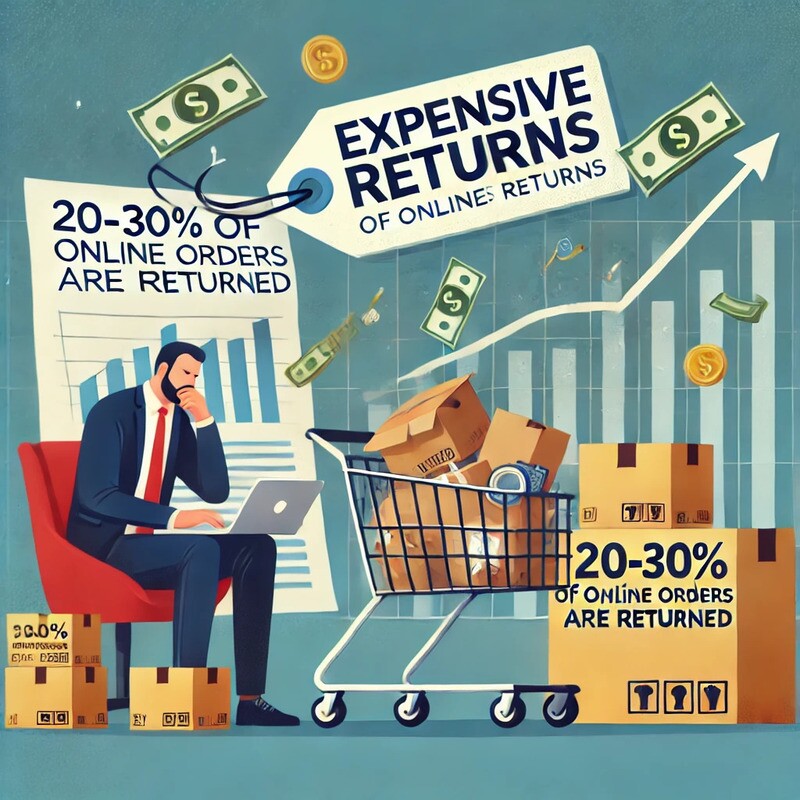
For each returned item, Amazon Third Party Sellers have already absorbed the product cost and the cost of preparing and shipping the inventory from their 3PL provider to multiple FBA fulfillment centers. Then, after an order is received, there are referral fees, fulfillment fees, and storage fees. What’s left after all the other sunk costs is the profit margin. If a customer initiates a free (or significantly subsidized) return, the Seller is expected to eat the costs of the return shipping, product inspection, and subsequent inventory management, which hurts the profit margin or may even turn the sale into a loss.
It’s no wonder many Sellers just offer to let customers keep low-cost items rather than return them because, at a certain point, it doesn’t make sense to process the return and resell it. Without careful cost management, Sellers can easily lose money on these transactions. To help Sellers recoup some value from returns and to get an even larger share of the Third-Party Sellers’ wallet, Amazon has now opened up the FBA Grade and Resell program to all Sellers that use FBA in the US.
Amazon FBA Grade and Resell Program
In the US and Europe, nearly 368MM items were either resold on Amazon in Used Condition or otherwise liquidated or donated last year. However, the FBA Grade and Resell program that enabled this success story was only available to a few Brands. Amazon has now made the program available to all Sellers that use FBA in the US, enabling all Sellers to recover value from inventory that would otherwise be removed or discarded by automatically inspecting, grading, and relisting eligible returned products as “Used” on Amazon’s marketplace. The program is particularly beneficial for items that can no longer be sold in New Condition but retain significant market value.
Not all products are eligible for FBA Grade and Resell. Specific categories are excluded, including but not limited to consumables, dangerous goods (hazmat) and recalled products, gift cards, heavy/bulky SKUs, and products with an average sale price that exceeds $75 (the complete list can be found here). Additionally, items must be returned to ecommerce fulfillment centers that support the program, and Sellers can exclude specific ASINs from the program for any reason.
How the FBA Grade and Resell Program Works
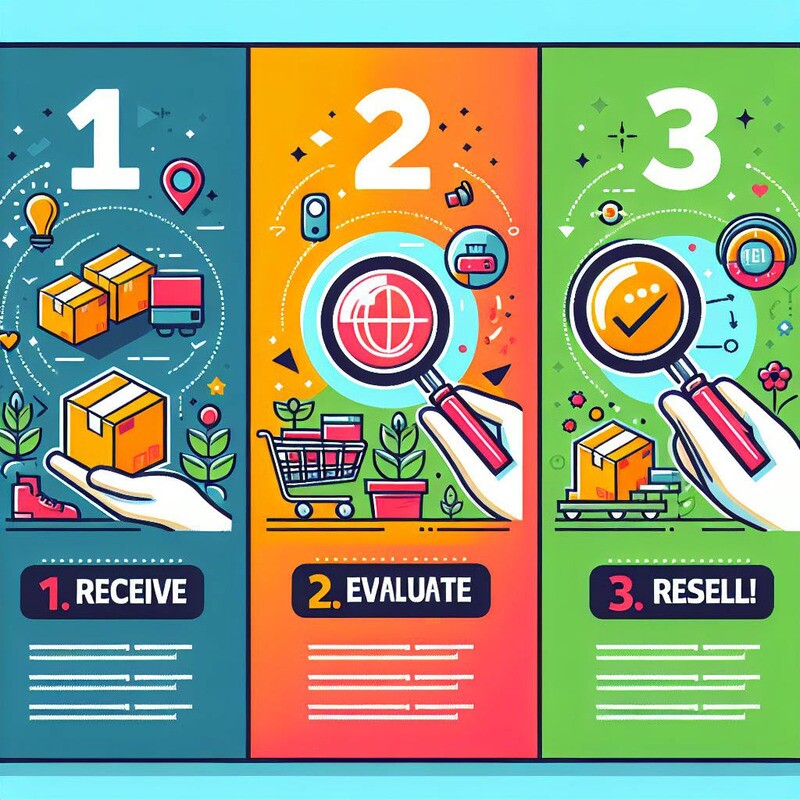
Sellers first enroll in the Grade and Sell program through the Automated Unfulfillable Settings in Seller Central. Once enrolled, eligible customer returns that are unsellable as New are processed through different evaluation paths based on the product type. These paths include non-technical, technical, and specialty grading.
Amazon’s grading process is described as thorough and tailored to each product category. It may include checking for catalog accuracy, inspecting for packaging defects, damage, or cosmetic blemishes, validating functionality, checking accessories, and even memory wiping and factory resetting certain electronics such as laptops and cameras.
After evaluation, items are assigned one of four conditions: Used-Like New, Used-Very Good, Used-Good, or Used-Acceptable. Items that don’t meet these standards are graded as Unsellable. For items graded as Used, Amazon creates a new listing under the parent ASIN in the “New and Used” offers section, with the Seller remaining as Seller of record. They are eligible to become the Used Featured Offer (the default buy box for Used items) if the Seller’s offer meets the pricing and performance criteria and is managed the same way New items are managed, including advertising and pricing. The grading process can take several weeks and longer during peak seasons, so plan accordingly.
Sellers manage the pricing discount that applies to all Used SKUs in the program as a percentage of the New Condition offer price. For example, a Seller might set offers for Used-Like New SKUs as “85%” of the New SKU offer price, which is applied automatically when units are relisted. Sellers should actively manage their pricing strategy to ensure their Used items remain competitive while providing a worthwhile return.
Slash Your Fulfillment Costs by Up to 30%
Cut shipping expenses by 30% and boost profit with Cahoot's AI-optimized fulfillment services and modern tech —no overheads and no humans required!
I'm Interested in Saving Time and MoneyBuilding a Sustainable Business Model
Building a sustainable business model is crucial for long-term success in the Amazon reselling business. A sustainable business model balances profitability, customer satisfaction, and environmental responsibility. Here are some tips to help you create a sustainable business model:
- Focus on High-Demand, Low-Impact Products: Prioritize selling products that are in high demand and have a low environmental impact. This approach not only ensures steady sales but also minimizes your ecological footprint.
- Eco-Friendly Packaging: Use eco-friendly packaging materials, such as recycled or biodegradable options. This not only appeals to environmentally conscious customers but also reduces waste.
- Recycling Programs: Implement a recycling program for returned or damaged products. This can help reduce waste and potentially recover some value from unsellable items.
- Utilize FBA Services: Consider using Amazon’s Fulfillment by Amazon (FBA) service. FBA can help reduce carbon emissions by optimizing shipping and logistics, and it also improves customer satisfaction with faster delivery times.
- Optimize Business Operations: Continuously monitor and optimize your business operations to reduce waste and improve efficiency. This can include streamlining your supply chain, reducing energy consumption, and minimizing unnecessary expenses.
By incorporating these practices, you can build a sustainable business model that not only benefits the environment but also enhances your brand’s reputation and profitability.
Managing and Monitoring Used Inventory
Sellers have several tools available to help manage Used (graded) inventory. The most important is the Grade and Resell Report, which provides real-time updates on inventory status, including how many units are graded and ready for resale.
Sellers will appreciate that customer feedback and reviews for graded items roll up to the parent ASIN and do not materially affect Account Health Metrics, ensuring that Seller’s reputation is not negatively compromised due to poorly graded units.
Marketing and Promoting Your Products
Marketing and promotion of your products boosts visibility, attracting customers and driving sales. Here are some effective strategies to boost your product visibility and sales:
- Amazon Advertising: Utilize Amazon’s advertising options, such as Sponsored Products and Sponsored Brands, to increase visibility and drive sales. These tools can help your products stand out in a crowded marketplace.
- Optimize Product Listings: Ensure your product listings are optimized with high-quality images, detailed descriptions, and relevant keywords. This improves your chances of appearing in search results and attracting potential buyers.
- Social Media Promotion: Leverage social media platforms like Facebook and Instagram to promote your products and engage with customers. Social media can be a powerful tool for building brand awareness and driving traffic to your listings.
- Discounts and Promotions: Consider offering discounts or promotions to attract customers and drive sales. Limited-time offers and special deals can create a sense of urgency and encourage purchases.
- Continuous Optimization: Continuously monitor and optimize your marketing strategy to improve results. Analyze your advertising performance, adjust your campaigns, and experiment with different promotional tactics to find what works best.
By implementing these marketing strategies, you can effectively promote your products, attract more customers, and increase your sales on Amazon.
Looking for a New 3PL? Start with this Free RFP Template
Cut weeks off your selection process. Avoid pitfalls. Get the only 3PL RFP checklist built for ecommerce brands, absolutely free.
Get My Free 3PL RFPFBA Grade and Resell Program Fees
Based on the item’s size and weight, sellers are charged a flat processing fee (from $1.50 – $4.10). However, items deemed completely unsellable remain in the Seller’s unfulfillable inventory and are not relisted nor processing fees charged. Sellers receive payouts for sold Used units just as they would for their New items, minus applicable fees. Amazon recommends enrolling SKUs with an average selling price above $15 to ensure profitability. Still, this guidance is highly subjective, and each Seller must monitor their eligible SKUs and adjust as necessary.
Benefits of the FBA Grade and Resell Program
There are several benefits of the FBA Grade and Resell program:
- Boost revenue: Recover value from inventory that would otherwise be a loss instead of removing/disposing returned items or selling them at a steep discount through liquidation channels by selling Used units to customers willing to accept them at a discount.
- Ease of Use: Sellers can automate submitting unfulfillable inventory into the Grade and Resell program, reducing the time and effort required to manage returned stock. Set it and forget it.
- Cost Efficiency: Sellers only pay a processing fee when an item is successfully relisted and can avoid paying to return or dispose of unsellable inventory.
- Faster time to market for Used: Units delivered directly to FBA fulfillment centers that support Grade and Resell compared to removing inventory, grading and prepping it externally, and then either Seller-fulfilling Used SKUs, or reinbounding to FBA
- Support sustainability: Reduce waste going to the landfill
Pitfalls of FBA Grade and Resell Program
- Imperfect humans resulting in poorly graded units: FBA employees may need to be more familiar with a product and what constitutes success criteria for passing inspection beyond the vague definitions provided in the condition guidelines. The subjective nature of the grading rubric would make it too easy to overestimate the grade as Like New when it’s actually in Acceptable condition, leading to customer complaints and poor reviews and/or brand image. And vice versa, under-grading an item limits the net recovery value from the resold item, leading to potential losses rather than gains.
- It’s expensive: For example, if a $30 home goods item is resold at 75% of the new price, ($22.50) after the Grade and Resell Processing fee ($1.80), Fulfillment fee ($6.75), and Referral fee ($3.38), the net recovered value is only $10.57, or 35.23% of the original offer price for the new condition listing. That’s less than the cost of the Fulfillment and Referral fees for the original sale of the new item. Besides the additional fees for Grade and Resell, Used items typically take longer to sell. They may require more active management of listings, including leveraging pricing and marketing tools to shrink the time to sale and, thus, avoid accumulating storage fees.
- Stranded inventory: If a Seller’s listing for a Used item is deleted, priced incorrectly, or otherwise not associated with an active offer, the product could become stranded, causing delays in selling and accumulation of storage fees.
Scaling Made Easy: Calis Books’ Fulfillment Journey
Learn how Calis Books expanded nationwide, reduced errors, grew sales while cutting headcount, and saved BIG with Cahoot
See Scale JourneyConclusion
Without truly transformative new returns models such as Cahoot’s Peer-to-Peer Returns, FBA Grade and Resell represents an attractive opportunity for Amazon Sellers to maximize the value of their returned inventory. By turning potential losses into sellable inventory, the program can help improve revenue and overall profitability, plus reduce waste.
However, like any tool, its effectiveness depends on how well it’s used. Sellers should carefully consider their pricing strategy, monitor the performance of their Grade and Resell listings, and be prepared to manage this inventory alongside their New Condition counterparts actively. For many FBA Sellers, it may be a valuable addition to their arsenal of tools for managing inventory and maximizing returns recovery. But for others, while this presents an opportunity to sell their Used returns (that may have otherwise gone to landfill), they need to be keenly aware of how much can be extracted from the resale after all the FBA fees, promotional costs, and landed costs are applied.
Frequently Asked Questions
What is FBA Grade and Resell?
FBA Grade and Resell is a new service for FBA sellers allowing the sale of returned items.
Is FBA Grade and Resell Available for All Products?
Not all products are eligible for for FBA Grade and Resell. You can learn more about which items are eligible from Amazon’s KB article.
How Does the Grading Process Work?
Amazon will inspect the returned items and assign a condition grade based on the product quality.

Turn Returns Into New Revenue

Analyze your Amazon FBA Returns to Optimize Performance
As a business owner you already know that returns are a pain, especially on Amazon.
First of all, they cost you. Not only do you have to refund the original purchase price, but the returned inventory might be damaged and unsellable or even the wrong product altogether, leading to a complete loss.
This would be the case in any retail business. But if you sell through Amazon FBA, you’ll encounter unique challenges. Amazon FBA return fees can add to the financial burden with returns processing fees, restocking fees, and other hidden costs.
If you choose the setting to have your returns go back to FBA to grade and resell, you run a risk: the FBA staff might make a mistake and end up sending another customer a damaged or used product. This could lead to a negative review and/or seller feedback that tanks your business’s reputation. (Have you heard about the small business that got wrecked because someone received a dirty used diaper?)
But if you have all returns sent back to you instead of trusting FBA, you have a major time loss on your hands: you and your staff now have to take the time to assess each item yourselves and either resell as new, resell as used, or dispose of it in some other way. Time is money in your business.
Plus, if you’re outside the US, you have to either set up a US-based return address for your US customers, provide a pre-paid international shipping label, or simply refund the item without requiring a return, all of which are expensive and potentially a hassle. (Failing to do one of the three makes the buyer eligible for an A-to-Z claim, which harms your order defect rate.)
Last but not least: if an item gets returned a lot compared to other items in its category, Amazon might add the frequently returned item warning to the listing, which could easily scare off buyers from purchasing the product, reducing your sales.
Amazon’s customer-centric mindset has led it to require third-party sellers to be very generous with their return policies all the time…and extra generous during the holiday peak season. While returns are usually allowed within 30 days, orders placed between November 1 and December 31 are usually eligible for return until the end of January.
Slash Your Fulfillment Costs by Up to 30%
Cut shipping expenses by 30% and boost profit with Cahoot's AI-optimized fulfillment services and modern tech —no overheads and no humans required!
I'm Interested in Saving Time and MoneyUnderstanding FBA Customer Returns
Navigating the world of Amazon FBA customer returns can feel like a maze, but understanding the process is crucial for managing your inventory and minimizing losses. When a customer decides to return an item, Amazon promptly sends you an email notification, and the cost of the order is deducted from your seller account balance. The customer then ships the item back to an Amazon fulfillment center, where it undergoes a thorough inspection to determine its condition. This step is vital as it decides whether the item can be resold, needs refurbishment, or is unsellable. By grasping this process, you can better manage your FBA inventory and make informed decisions about handling returns.
How to Analyze Your FBA Returns
First, you’ll need to understand why returns are happening. The best way to do that is to go straight to the buyers themselves. Buyers have to choose a reason when they request to return something, and they have a space to leave a comment with more details as well. Notice any patterns in the return reasons, and read the comments to try to understand where buyers are coming from.
It may seem daunting to read through all returns for every item, especially if your catalog is large. So, prioritize. Your process might look something like this:
- Identify the SKU that has the highest return rate, while also having enough sales to be worth your focus. For example, look at your ten top-selling parent ASINs, then choose the SKU among those that have the most returns in the last 90 days.
- Next, look at the top two or three return reasons customers choose for this item.
- Read through a substantial sample of the return comments for each of those reasons.
- Repeat with another high-selling and frequently returned SKU.
SellerPulse by eComEngine is a software tool that provides these details fast. It includes a robust FBA returns report with easy-to-read graphs showing which items are most often returned in which condition or for which reason, plus a word cloud of common themes in the comments. All the individual remarks are imported too, so you can notice a theme and dig in to get more details about the buyers’ experiences.
The report also shows returns over time, item disposition (the condition the item was returned in), and more, to save time and improve returns analysis.
Identifying Reasons for FBA Returns
Understanding why customers return products is key to improving your offerings and reducing return rates. Amazon provides a comprehensive list of 72 official reasons for customer returns, which can be broadly categorized into three groups: customer-related, seller-related, and Amazon-related.
Customer-related reasons might include issues like the product not meeting expectations or a change of mind. Seller-related reasons often involve inaccuracies in the product listing or quality issues. Amazon-related reasons could be due to shipping errors or fulfillment center mishandling. By analyzing these reasons, you can identify patterns and take corrective actions, such as improving product descriptions, enhancing quality control, or addressing fulfillment issues, to minimize future returns.
Of course, one benefit of doing this research is that it allows you to collect evidence of any fraudulent returns to make your case to Amazon.
But there are plenty of non-fraudulent returns and plenty of ways to reduce those going forward. Over time, you can improve your product, listing, packaging, or service to prevent the issues you’re seeing in the reasons and comments.
For example, if many buyers are saying that a certain item arrived damaged, you may need to improve the packaging it comes in for extra durability, rather than relying on FBA to pack it with the proper amount of cushion.
Or, if many buyers are complaining that the size, color, or other features of the item are not what they expected, you may need to update the listing to be more accurate to the real product.
Looking for a New 3PL? Start with this Free RFP Template
Cut weeks off your selection process. Avoid pitfalls. Get the only 3PL RFP checklist built for ecommerce brands, absolutely free.
Get My Free 3PL RFPMinimizing Losses from FBA Returns
Reducing losses from FBA returns requires a proactive and strategic approach. Here are some effective strategies to help you minimize these losses:
- Improve product quality: Ensure your products meet high-quality standards and customer expectations to reduce returns due to defects or damage.
- Optimize product listings: Make sure your product listings are accurate and comprehensive to prevent returns caused by misleading or incorrect information.
- Use removal orders: Utilize removal orders to inspect returned items and assess their condition. This can help you decide whether to resell, refurbish, or dispose of the items, thereby minimizing losses.
- Leverage Amazon’s return policies: Familiarize yourself with Amazon’s return policies and use options like the “Returnless Refund” to handle returns more efficiently and reduce costs.
By implementing these strategies, you can better manage FBA returns and protect your bottom line.
Conclusion
Effectively managing FBA customer returns is a critical component of success on Amazon. By understanding the return process, identifying the reasons behind returns, and taking steps to minimize losses, you can enhance your overall performance and profitability. Following the strategies outlined in this article will help you reduce returns, improve customer satisfaction, and stay competitive in the Amazon marketplace. Start analyzing your FBA returns today to set yourself up for a successful year ahead.
Frequently Asked Questions
What are the most common reasons for FBA returns?
The most common reasons listed for FBA returns are inaccurate product descriptions, damage in transit, poor product quality, and buyer’s remorse, most commonly deriving from some unmet expectation about the product.
What is the FBA policy for reimbursing unsellable items?
For items deemed unsellable, Amazon assesses responsibility for the damage. If it is determined to be Amazon’s responsibility, they will reimburse you. If the damage is attributed to the customer or falls under specific categories—such as customer-damaged items, recalled products, defective items, or violations of Amazon policies—Amazon does not accept responsibility and will not reimburse you. These items remain in your inventory as unsellable, and you may choose to have them returned to you or disposed of. Additionally, if a customer is refunded but does not return the item to an Amazon fulfillment center within 60 days, Amazon typically charges the customer and reimburses you.
How do I contest returns I believe are fraudulent?
If you believe a return is fraudulent, you should contact Amazon customer service to report a suspicious return immediately. You can also file an “Abusive Buyer Report” through Seller Central with any evidence of fraud you have compiled. Additionally, Amazon policies can be used to dispute returns you believe are fraudulent, including requesting an item inspection.

Turn Returns Into New Revenue




